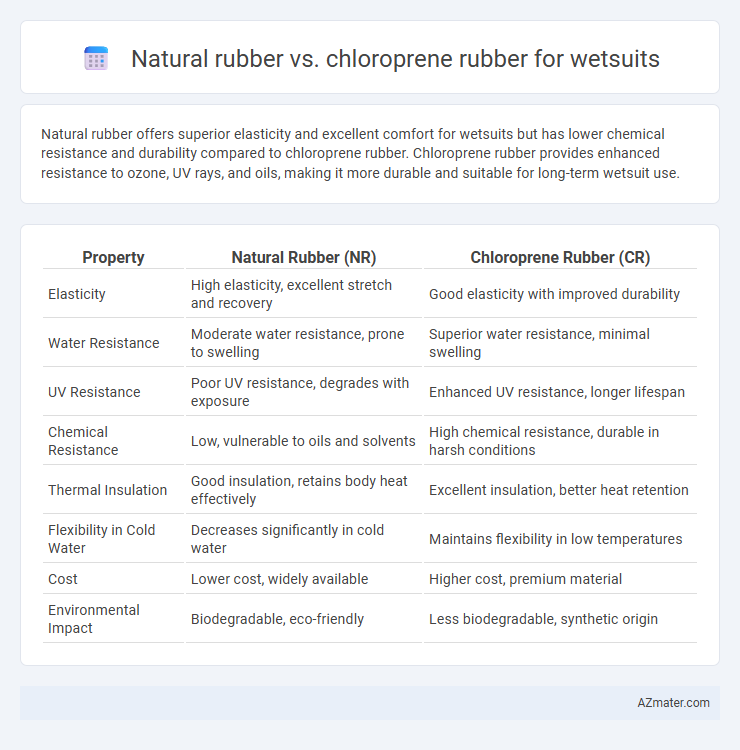Natural rubber offers superior elasticity and excellent comfort for wetsuits but has lower chemical resistance and durability compared to chloroprene rubber. Chloroprene rubber provides enhanced resistance to ozone, UV rays, and oils, making it more durable and suitable for long-term wetsuit use.
Table of Comparison
| Property | Natural Rubber (NR) | Chloroprene Rubber (CR) |
|---|---|---|
| Elasticity | High elasticity, excellent stretch and recovery | Good elasticity with improved durability |
| Water Resistance | Moderate water resistance, prone to swelling | Superior water resistance, minimal swelling |
| UV Resistance | Poor UV resistance, degrades with exposure | Enhanced UV resistance, longer lifespan |
| Chemical Resistance | Low, vulnerable to oils and solvents | High chemical resistance, durable in harsh conditions |
| Thermal Insulation | Good insulation, retains body heat effectively | Excellent insulation, better heat retention |
| Flexibility in Cold Water | Decreases significantly in cold water | Maintains flexibility in low temperatures |
| Cost | Lower cost, widely available | Higher cost, premium material |
| Environmental Impact | Biodegradable, eco-friendly | Less biodegradable, synthetic origin |
Introduction: Natural Rubber vs Chloroprene Rubber
Natural rubber offers excellent elasticity and flexibility, making it a traditional choice for wetsuits that require a close fit and superior comfort. Chloroprene rubber, commonly known as neoprene, provides enhanced chemical resistance, durability, and thermal insulation, which contributes to better performance in cold water conditions. The choice between natural rubber and chloroprene depends on the balance of flexibility, durability, and environmental factors desired in wetsuit applications.
What is Natural Rubber?
Natural rubber, derived from the latex sap of Hevea brasiliensis trees, offers superior elasticity, flexibility, and water resistance, making it a preferred material for wetsuits. Its biodegradable and renewable nature enhances environmental sustainability compared to synthetic alternatives like chloroprene rubber. The high tensile strength and excellent thermal insulation properties of natural rubber provide effective warmth and durability in cold water conditions.
What is Chloroprene Rubber (Neoprene)?
Chloroprene rubber, commonly known as neoprene, is a synthetic rubber widely used in wetsuits due to its excellent insulation, flexibility, and resistance to water, oils, and weathering. Unlike natural rubber, neoprene offers superior durability and maintains its elasticity and performance in extreme temperatures and underwater conditions. Its closed-cell foam structure traps air, providing enhanced thermal insulation essential for wetsuit applications.
Environmental Impact and Sustainability
Natural rubber, derived from the latex of rubber trees, offers a renewable and biodegradable alternative to synthetic chloroprene rubber used in wetsuits, significantly reducing environmental pollution and carbon footprint. Chloroprene rubber production relies on petrochemicals, contributing to greenhouse gas emissions and generating persistent waste that challenges sustainability goals. Sustainable wetsuit manufacturers increasingly favor natural rubber for its lower ecological impact and potential to promote reforestation efforts in rubber-producing regions.
Comfort and Fit: Material Performance
Natural rubber offers exceptional elasticity and softness, providing a snug yet comfortable fit crucial for wetsuits, adapting well to body movements and reducing restrictions. Chloroprene rubber, while also flexible, tends to be slightly stiffer, offering enhanced durability and thermal insulation but potentially less conforming to the body's contours. The superior stretch and breathability of natural rubber contribute to better overall comfort during prolonged water activities, whereas chloroprene balances performance with resilience.
Thermal Insulation and Warmth
Natural rubber offers superior elasticity and breathability, but its thermal insulation for wetsuits is generally less effective compared to chloroprene rubber. Chloroprene rubber, commonly known as neoprene, provides enhanced thermal insulation by trapping heat and maintaining warmth in cold water conditions due to its closed-cell foam structure. This makes chloroprene the preferred material for wetsuits aiming to deliver optimal warmth and insulation during prolonged aquatic activities.
Durability and Resistance to Wear
Natural rubber offers excellent elasticity and comfort but tends to degrade faster under UV exposure and prolonged water contact, reducing its durability in wetsuit applications. Chloroprene rubber, known as neoprene, provides superior resistance to abrasion, ozone, and chemical wear, making it more durable and better suited for long-term use in aquatic environments. Its enhanced wear resistance ensures wetsuits maintain flexibility and protective properties over extended periods, outperforming natural rubber in durability metrics.
Flexibility and Stretch Characteristics
Natural rubber offers superior flexibility and excellent stretch characteristics, providing a comfortable and form-fitting wetsuit that moves naturally with the body. Chloroprene rubber, commonly known as Neoprene, balances flexibility with enhanced durability and resistance to environmental factors like ozone and UV exposure. While natural rubber excels in softness and elasticity, chloroprene is preferred for wetsuits requiring longer lifespan and moderate stretch performance.
Skin Sensitivity and Allergic Reactions
Natural rubber wetsuits often trigger allergic reactions due to latex proteins causing skin sensitivity, making them less suitable for individuals with latex allergies. Chloroprene rubber, commonly known as neoprene, offers superior hypoallergenic properties and is widely preferred because it minimizes the risk of skin irritation and allergic responses. Selecting chloroprene wetsuits reduces the likelihood of dermatitis and enhances comfort for sensitive skin during prolonged water exposure.
Cost Comparison and Value
Natural rubber wetsuits generally offer a lower upfront cost due to the abundance and renewable sourcing of latex, making them an economical choice for budget-conscious consumers. Chloroprene rubber, commonly known as neoprene, commands a higher price because of its enhanced durability, flexibility, and superior insulation properties, which provide greater long-term value. When weighing cost against performance, chloroprene wetsuits often deliver better overall value through extended lifespan and improved thermal retention despite the initial higher investment.

Infographic: Natural rubber vs Chloroprene rubber for Wetsuit
 azmater.com
azmater.com